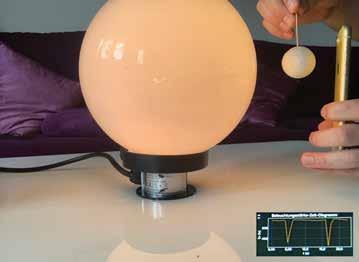
12 minute read
astro-lab@home – Bringing Science to the Sofa
Sebastian J. Spicker,
Institute of Physics Education, University of Cologne sebastian.spicker@hfmt-koeln.de
Advertisement
Alexander Küpper
Institute of Physics Education, University of Cologne
André Bresges
Institute of Physics Education, University of Cologne
Keywords
exoplanets, DIY, astronomy education, STEM
While public interest in astronomical topics remains high, astronomy education facilities (e.g., school-labs) and outreach initiatives (e.g., observatories) have had to close (and remain closed) due to the Covid-19 pandemic. One of these facilities concerned is the astro-lab of the University of Cologne, where young learners used analogy experiments to explore how exoplanets can be discovered and analysed. Out of the desire to make the original astro-lab experiments accessible to a larger audience (e.g., students, teachers, and the general public) from a distance, the astro-lab@home idea was born. The project is based on the high accuracy of sensors built into modern smartphones, making them the ideal measuring tool for home experimentation. This article describes how everyday materials and smartphones can be used for experiments@ home in the context of exoplanets.
Introduction
Student labs are very popular in Germany because they enable actionoriented, cooperative work in a laboratory environment and contribute strongly to the formation of interests in the STEM fields (science, technology, engineering, and mathematics; Reimann et al., 2020). One example of a student lab is the astro-lab at the University of Cologne (UoC; Küpper & Schulz, 2017) which focuses on detecting and analysing extrasolar planets. Such context-oriented projects, that match learners’ interests, like the question of “Life in the Universe” (Sjøberg, 2012), have a particularly positive effect on learning success (Harackiewicz et al., 2016). To engage (young) learners and the general public in physics and astronomy, various experiments have been developed that focus on how exoplanets can be detected and the conditions that prevail on them, for example temperature, air pressure, atmospheric composition, albedo, and radiation, to be suitable for life (Küpper & Schulz, 2017).
However, when the pandemic reached Germany in spring 2020, schools shut down, and visits to the astro-lab were forbidden. Despite the restrictions, we wished to continue to inspire students, support teachers through motivating home-schooling resources and reach anyone interested in astronomy. As a result, we designed the astro-lab@home described in this article.
Astro-lab@home – bringing science to the sofa
One of the challenges of the “new normal” is to continue offering highquality education and outreach resources independent of a specific location. This requires working with what is available, for example, the materials available at home: smartphones and everyday materials. Since modern smartphones have a variety of accurate sensors, and several studies indicate that smartphone use is ubiquitous (Anderson & Jiang, 2018; mfps, 2019; OECD, 2020), students factually possess “a lab in the pocket” (Stampfer et al., 2020). Furthermore, smartphones allow flexibility in the time and place of use, and young learners already have extensive experience with smartphones (Anderson & Jiang, 2018).
Based on these findings, the original astrolab experiments (Küpper & Schulz, 2017), which can be performed with common lab materials and without smartphones, have been simplified and, in some cases, adapted so they can be done from home using everyday materials. In most of the following experiments, the measurement is performed with Android1 smartphones and the free app, phyphox (Stampfer et al., 2020). Furthermore, in each experiment, the data can be exported (e.g., in CSV format) and analysed later with another program in more detail.
Below we will briefly describe each of the astro-lab@home experiments.
Discovery of Exoplanets
In the first experiment, the user rotates a “planet” (e.g., a painted styrofoam ball) around a “star” (e.g., a light bulb) and studies the light curve (illuminance as a function of time). One will notice a periodic pattern of decreasing illuminance and associate this with the shadow of the ‘planet’ on the sensor (primary transit; Figure 1).
The experiment uses phyphox as an optical stopwatch that automatically calculates the transit depth, transit duration, and the duration of a year on the “planet”. Furthermore, the light curve is displayed in real-time. Thus, the user learns how
Figure 1. Transit-Experiment@home with possible curve using a garden light, a styrofoam ball, a toothpick, and a smartphone. Credit: A. Küpper and S. J. Spicker Figure 2. Albedo-Experiment@home with possible curve using a garden light, a Christmas ornament, and a smartphone. Credit: A. Küpper and S. J. Spicker
Figure 3. Tidal Locking-Experiment@home with a garden light and a smartphone. Credit: A. Küpper and S. J. Spicker
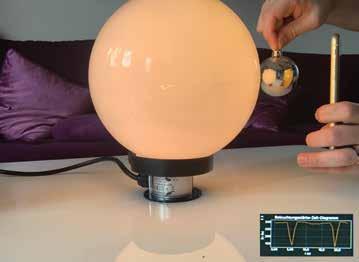
exoplanets can be detected via the transit method and which properties of an exoplanet can be deduced from the light curve (Spicker & Küpper, 2022).
Albedo of Exoplanets
By changing the “planet” to something highly reflective (e.g., Christmas ornament or a ball of aluminium foil), a secondary transit – in which reflected light from the planet is blocked when the planet orbits behind the star – can be made visible, and the albedo of exoplanets can be discussed. This way, the user can learn about reflectivity and its importance for temperature on the planet (Figure 2). Since the changes in the light curve due to the secondary transit are much smaller than in the discovery of exoplanets experiment, it might be helpful to either zoom into the graph in phyphox or export the data and re-examine it in a different piece of software.
Tidal Locking
If the smartphone2 is instead rotated around the light source and/or its own axis the user can learn about synchronous rotation and its effects on the planet’s surface temperature. In the experiment, the user creates a permanent day (night) side and compares the illuminance on each side of the planet (Figure 3).
Thus, the user will learn how day and night on (exo-)planets are created and the fundamentals of tidal locking.
Analysing Exoplanets’ Atmospheres
When an exoplanet is found (e.g., using the transit method), the composition of the exoplanet’s atmosphere plays a decisive role in the theoretical existence of life. The app Elements of the atmospheres of exoplanets (Hissel, 2020), developed at the UoC, can be used to discuss (fictive) absorption spectra (Figure 4).
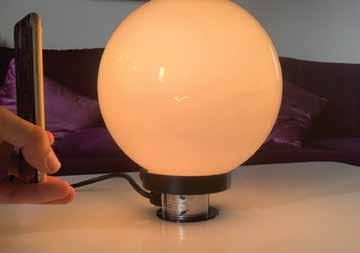
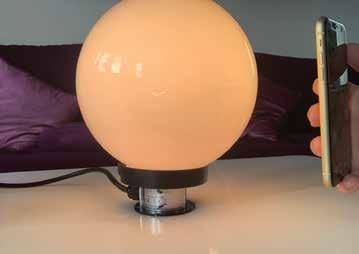
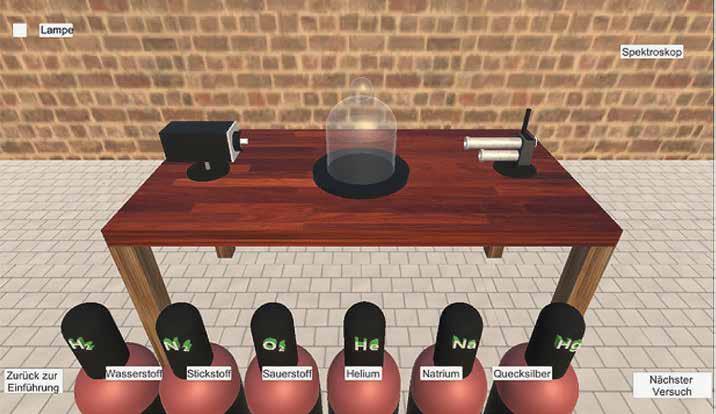
Figure 4. Screenshot from the ‘Elements of the atmospheres of exoplanets’-app. Credit: J.-N. Hissel
Figure 5. Habitable Zone@home with possible curve using a Bluetooth mouse, an external sensor, and an infrared lamp. Credit: A. Küpper and S. J. Spicker
For this purpose, “measurements” are made for the primary and secondary transits. By subtracting the light curves produced during the primary and secondary transits, the user can derive properties of the “planet’s” atmosphere.
For the following experiments, additional devices are required. We used phyphox with an external sensor device (TI SensorTag CC2650) and a Bluetooth-lowenergy mouse.
Habitable Zone
Even if an exoplanet’s atmosphere seems promising, it could be that the planet is not within the star’s habitable zone, which would render the planet incompatible with life. This is the topic of this experiment. The sensor is placed on the Bluetooth mouse and moved away from the radiation source (e.g., infrared lamp). Meanwhile, infrared intensity is measured as a function of distance and automatically visualised in phyphox (Figure 5). Through this, the user learns about the relationship between intensity and distance: the closer the “planet” is to the “star”, the higher the radiation, and vice versa. With the help of supplementary materials, which link radiation to temperature, the user thus concludes that there must be an optimal distance (or range of distances: the habitable zone) in which the temperature is optimal for life as we know it.
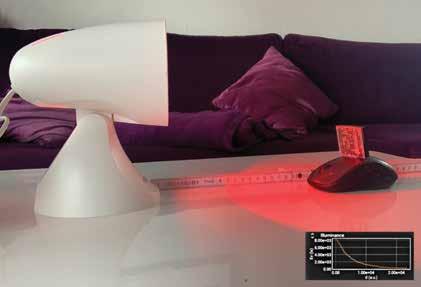
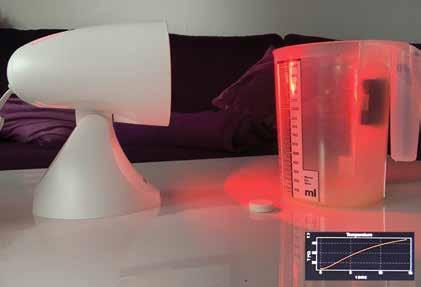
Figure 6. Greenhouse-effect@home with possible curve using one transparent container, an infrared lamp, and one external sensor. Credit: A. Küpper and S. J. Spicker
Greenhouse Effect and Exoplanets
As a follow-up experiment, the user uses an infrared lamp to irradiate transparent containers with different gases (e.g., air vs CO2 from a dissolved fizzy tablet) in which a temperature sensor (e.g., a SensorTag) is installed2. During the irradiation period, each temperature is measured over 15 minutes (Figure 6). the question of crew safety (Spicker et al., 2022).
Conclusion
By using astro-lab@home, qualitative connections in the context of extrasolar planets can be developed. Since the experiments can be performed quickly and cost-effectively with everyday materials, it is possible to experiment even in times of confinement. With the help of apps (e.g., phyphox, Pasco SPARKvue, PocketLabs) in the analogy or demonstration experiments, data collection and analysis are combined (O’Brien, 2021). In this way, the user is not overwhelmed by the need to measure and understand simultaneously. Also, advanced users can export the data to investigate in a program of choice. Furthermore, since phyphox now also supports Arduino, the user can build or use their own sensors. For this, the experiments must be reprogrammed to suit the respective sensor4. This underlines the scientific character and can be used to learn and teach basic programming or data analysis skills.
If the experiments are performed at home (instead of during science lessons at school as shown in Spicker & Küpper, 2022), students can either perform the experiments independently or in small groups. In both cases, the results of the experiments can be presented to the whole class at a later time. The use of technical terminology and other communication skills can be strengthened through direct video chat or presentations (Arkorful & Abaidoo, 2014).
By comparing the measurement curves and final values, the user can discuss the greenhouse potential of the test gases and compare it qualitatively with the situation on Earth.
Building Spaceship “Prototypes”
Once a promising candidate for an exoplanet has been identified from the above attempts, the question remains: how can humanity reach that planet? An important and often unnoticed factor for human life is air pressure, and as such, the effects of air pressure on the human body are discussed in this experiment. In particular, the user learns about the importance of pressure differences by building and testing “spacecraft” prototypes (e.g., with a vacuum cleaner; Figure 7).
Meanwhile, the pressure is measured over time by the sensor in the “spaceship”3. The user then analyses the curve and explores
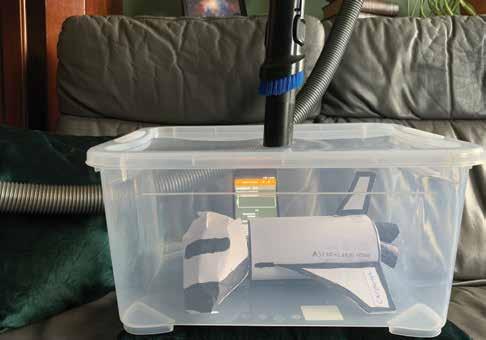
Figure 7. Testing spaceship “prototypes”@home with everyday materials, including plumbing pipes, sealable containers, cardboard, vacuum cleaner, and a smartphone. Credit: S. J. Spicker and A. Küpper
All presented experiments on exoplanets and more (e.g., star formation) can be downloaded from our website astrolab.app and added directly to phyphox using the provided QR code. For each experiment, additional information and instructional videos are also provided.
astro-lab@home and the open educational resources provided on the astro-lab.app can increase the interest in physics and physics learning not only locally at the astro-lab in Cologne itself, but worldwide, in regular classes or even from home. Since it is currently unclear to what extent there will be a return to “normal” in the foreseeable future, it is important to involve e-learning formats (O’Brien, 2021) like those presented above. Therefore, we invite all colleagues to participate and to (further) develop the presented materials5 .
Notes
1 Because the light sensor is not accessible via iOS, one needs an external sensor device. The authors suggest a TI CC2650 SensorTag or similar. 2 Can support up to two external sensors. 3 Although the experiment can be performed with both iOS and Android devices, as each has a built-in pressure sensor, we recommend using an external sensor to avoid damage to the device. 4 For an overview of compatible sensors, we refer to the website of the developers: phyphox.org. For Arduino use, please follow the instruction: astro-lab.app/arduino-undphyphox 5 If you would like to network or share your own content, please contact us directly or via the contact form on the astro-lab.app website.
References
Anderson, M., & Jiang, J. (2018). Teens, Social
Media & Technology 2018. Pew Research
Center. https://assets.pewresearch.org/ wp-content/uploads/ sites/14/2018/05/31102617/PI_2018.05.31_
TeensTech_FINAL.pdf Arkorful, V., & Abaidoo, N. (2014). The role of e-learning, advantages, and disadvantages of its adoption in higher education.
International Journal of Education and
Research, 2(12), 397–410. https://www.ijern. com/journal/2014/December-2014/34.pdf Harackiewicz, J. M., Smith, J. L., & Priniski, S.
J. (2016). Interest Matters: The Importance of Promoting Interest in Education. Policy
Insights from the Behavioral and Brain
Sciences, 3(2), 220–227. Hissel, J.-N. (2020). Elemente der Atmosphäre von Exoplaneten (Elements of the atmospheres of exoplanets) (1.0) [Mobile and computer app]. https://astro-lab.app/ elemente-der-atmosphaere-vonexoplaneten/ Küpper, A., & Schulz, A. (2017). Schülerinnen und Schüler auf der Suche nach der Erde 2.0 im Schülerlabor der Universität zu Köln.
Astronomie + Raumfahrt im Unterricht, 54(1), pp. 40–45. https://www.fachportalpaedagogik.de/en/literatur/vollanzeige. html?FId=1113696 Medienpädagogischer Forschungsverbund
Südwest (mfps). (2019). JIM-Studie 2019 –
Jugend, Information, Medien. https://www. mpfs.de/fileadmin/files/Studien/JIM/2019/
JIM_2019.pdf O’Brien, D. J. (2021). A guide for incorporating e-teaching of physics in a post-COVID world. American Journal of Physics, 89(4), 403–412. https://doi.org/10.1119/10.0002437 OECD (2020), OECD Digital Economy Outlook 2020. OECD Publishing, Paris, https://doi. org/10.1787/bb167041-en Reimann, M., Herzog, S., Parchmann, I., &
Schwarzer, S. (2020). Effectiveness of
Preparation and Follow-up Lessons in
School of a Student Lab Visit. Zeitschrift für
Didaktik der Naturwissenschaften, 26(1), 227–240. https://doi.org/10.1007/s40573020-00121-y Sjøberg, S. (2012). Young people’s attitudes to science – Results and perspectives from the
ROSE study. In U. Pfenning & O. Renn (Eds.), Wissenschafts- und Technikbildung auf dem Prüfstand (pp. 111–126). Nomos. https://doi.org/10.5771/9783845238289-111 Spicker, S.J., & Küpper, A. (2022). astro-lab@ school: ein Schülerlabor 2.0 für den Physik- und Astronomieunterricht. Astronomie +
Raumfahrt im Unterricht, 59(1), pp. 16–21. https://elibrary.utb.de/doi/pdf/10.5555/ ar-185-2022_04 Spicker, S. J., Küpper, A., & Bresges, A. (2022). Mission to mars – Concept and implementation of a design-based (hands-on) smartphone-experiment helping students understand the effects caused by differences in air pressure. The Physics
Teacher, 60(47), pp. 47–50. https://doi. org/10.1119/10.0009109 Stampfer, C., Heinke, H., & Staacks, S. (2020).
A lab in the pocket. Nature Reviews
Materials, 5(3), 169–170. https://doi. org/10.1038/s41578-020-0184-2
Biographies
Sebastian J. Spicker is a physicist working in IT at the Cologne University of Music. Before, Sebastian worked at the Future Strategy of Teacher Education at the University of Cologne. His main interests are developing astronomy educational resources and mobile learning. Astronomy is his passion.
Alexander Küpper is a physicist currently working as a teacher at a secondary school. Before, Alexander worked as a scientist at the Institute of Physics Education at the University of Cologne. His research interests are astronomy at school (laboratories) and inclusive science education.
André Bresges is the head of the Institute of Physics Education at the University of Cologne. André does research in Teacher Education, Science Education, and Educational Technology.






